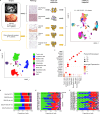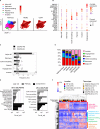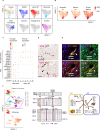Cellular origin and clonal evolution of human dedifferentiated liposarcoma
- PMID: 39266532
- PMCID: PMC11393420
- DOI: 10.1038/s41467-024-52067-1
Cellular origin and clonal evolution of human dedifferentiated liposarcoma
Abstract
Dedifferentiated liposarcoma (DDLPS) is the most frequent high-grade soft tissue sarcoma subtype. It is characterized by a component of undifferentiated tumor cells coexisting with a component of well-differentiated adipocytic tumor cells. Both dedifferentiated (DD) and well-differentiated (WD) components exhibit MDM2 amplification, however their cellular origin remains elusive. Using single-cell RNA sequencing, DNA sequencing, in situ multiplex immunofluorescence and functional assays in paired WD and DD components from primary DDLPS tumors, we characterize the cellular heterogeneity of DDLPS tumor and micro-environment. We identify a population of tumor adipocyte stem cells (ASC) showing striking similarities with adipocyte stromal progenitors found in white adipose tissue. We show that tumor ASC harbor the ancestral genomic alterations of WD and DD components, suggesting that both derive from these progenitors following clonal evolution. Last, we show that DD tumor cells keep important biological properties of ASC including pluripotency and that their adipogenic properties are inhibited by a TGF-β-high immunosuppressive tumor micro-environment.
© 2024. The Author(s).
Conflict of interest statement
The authors declare no competing interests.
Figures







References
-
- Board, W.C.o.T.E. WHO Classification of Tumours: Soft Tissue and Bone Tumours, (International Agency for Research on Cancer, 2020).
Publication types
MeSH terms
Substances
Associated data
- Actions
- BioProject/PRJNA113972
Grants and funding
LinkOut - more resources
Full Text Sources
Molecular Biology Databases
Research Materials
Miscellaneous

